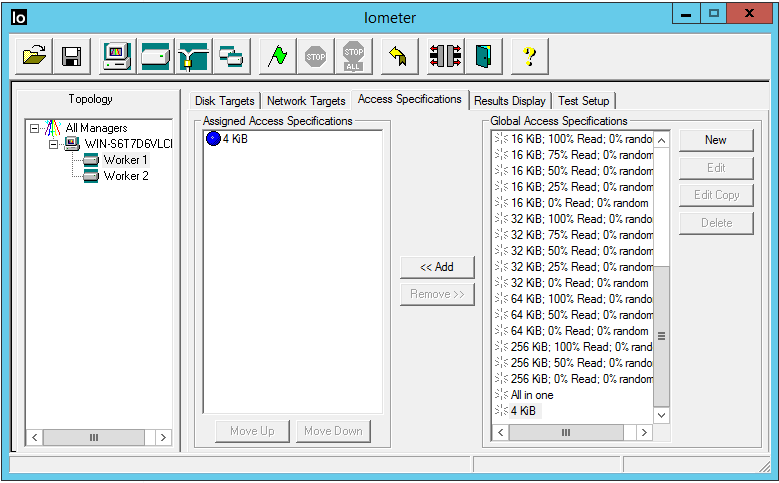The below code collects disk IOPS and average IO latency of a list of servers and output the real time values.
Note: Here we are monitoring only logical disk E of testvm-01, testvm-02 and testvm-03
while($true)
{
$Servers = "testvm-01","testvm-02","testvm-03"
$R_io = '\LogicalDisk(E:)\Disk Reads/sec'
$W_io = '\LogicalDisk(E:)\Disk Writes/sec'
$Lat = '\LogicalDisk(E:)\Avg. Disk sec/Transfer'
$Reads = (Get-Counter -Counter $R_io -ComputerName $Servers).CounterSamples.CookedValue
$Writes = (Get-Counter -Counter $W_io -ComputerName $Servers).CounterSamples.CookedValue
$Latency = (Get-Counter -Counter $Lat -ComputerName $Servers).CounterSamples.CookedValue
clear
"{0,-15} {1,-15} {2,-15} {3,-15} {4, -15}" -f "Host", "Reads/Sec", "Writes/Sec", "Total IOPS", "Avg Latency (ms)"
echo `n
for($i=0; $i -le 2; $i+=1){
[int]$R = $Reads[$i]
[int]$W = $Writes[$i]
[int]$T = $R+$W
[int]$L = ($Latency[$i])*1000
[String]$N = $Servers[$i]
"{0,-15} {1,-15} {2,-15} {3,-15} {4,-15}" -f "$N", "$R", "$W", "$T", "$L"
}
}
Note: Here we are monitoring only logical disk E of testvm-01, testvm-02 and testvm-03
while($true)
{
$Servers = "testvm-01","testvm-02","testvm-03"
$R_io = '\LogicalDisk(E:)\Disk Reads/sec'
$W_io = '\LogicalDisk(E:)\Disk Writes/sec'
$Lat = '\LogicalDisk(E:)\Avg. Disk sec/Transfer'
$Reads = (Get-Counter -Counter $R_io -ComputerName $Servers).CounterSamples.CookedValue
$Writes = (Get-Counter -Counter $W_io -ComputerName $Servers).CounterSamples.CookedValue
$Latency = (Get-Counter -Counter $Lat -ComputerName $Servers).CounterSamples.CookedValue
clear
"{0,-15} {1,-15} {2,-15} {3,-15} {4, -15}" -f "Host", "Reads/Sec", "Writes/Sec", "Total IOPS", "Avg Latency (ms)"
echo `n
for($i=0; $i -le 2; $i+=1){
[int]$R = $Reads[$i]
[int]$W = $Writes[$i]
[int]$T = $R+$W
[int]$L = ($Latency[$i])*1000
[String]$N = $Servers[$i]
"{0,-15} {1,-15} {2,-15} {3,-15} {4,-15}" -f "$N", "$R", "$W", "$T", "$L"
}
}








